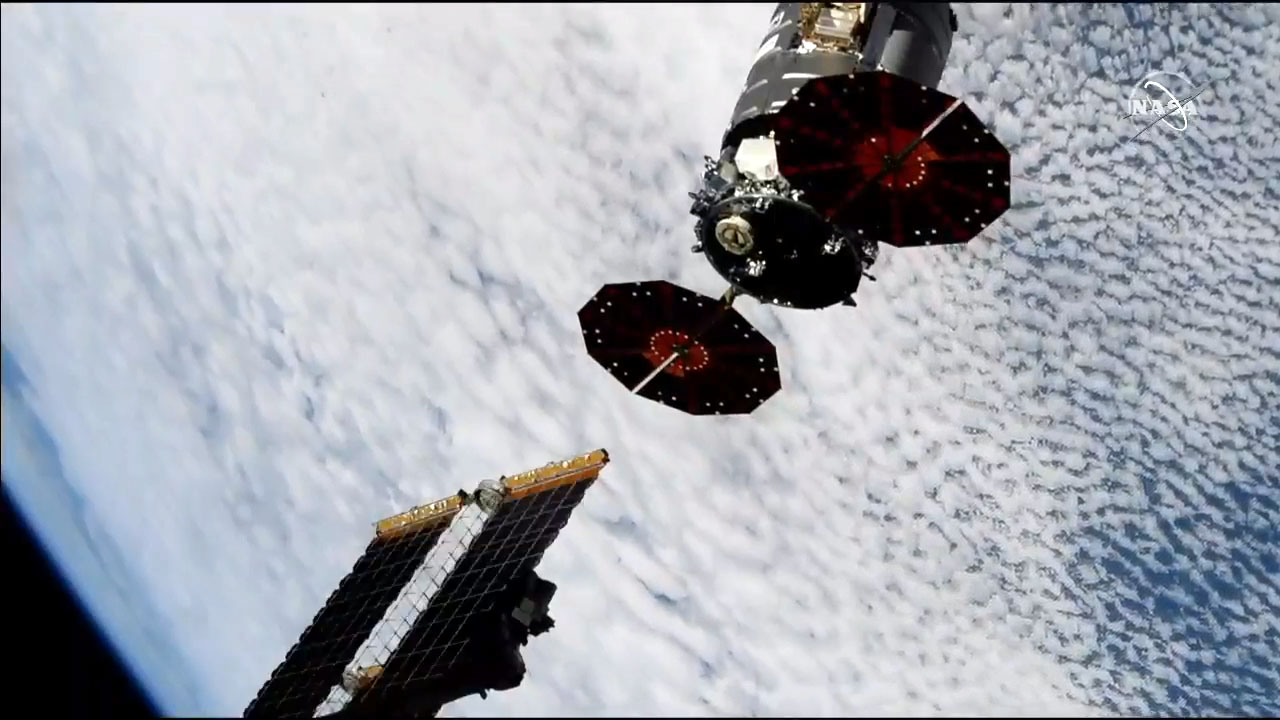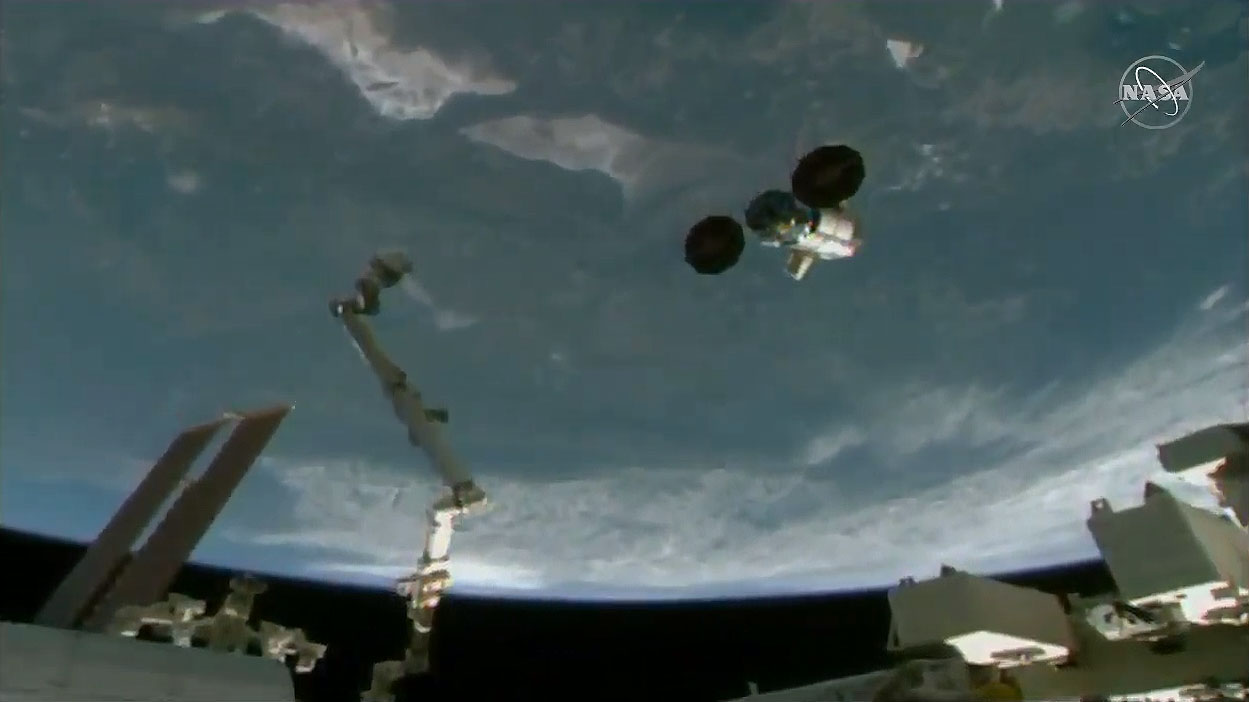Cygnus cargo ship leaves International Space Station, begins new mission in orbit
Northrop Grumman's Cygnus NG-12 cargo spacecraft departed the International Space Station today (Jan. 31), nearly three months after it arrived at the orbiting laboratory with about 4 tons of supplies and science experiments for the Expedition 61 crew.
The cargo vessel, named the S.S. Alan Bean after the Apollo 12 astronaut, began its journey back to Earth after ground controllers in Houston used the station's Canadarm2 robotic arm to release it in orbit. Before the spacecraft meets its fiery demise in Earth's atmosphere, it will spend about a month in orbit deploying various scientific payloads.
On Feb. 29, ground controllers will initiate a deorbit maneuver, after which the cargo ship will execute "a safe, destructive reentry into Earth’s atmosphere," NASA officials said in a statement.
Video: See stunning Earth views as Cygnus spacecraft departs space station
Related: Antares rocket launches Cygnus NG-12 cargo craft (photos)

"I’d just like to say farewell to the S.S. Alan bean and thank you to the entire Cygnus NG-12 team for making Expedition 61 highly successful," NASA astronaut and Expedition 61 flight engineer Andrew Morgan said during a live webcast of the spacecraft's departure. He and his fellow Expedition 61 crewmember Jessica Meir provided backup support as ground controllers maneuvered the Cygnus away from the space station.
While this isn't the first Cygnus cargo vessel to embark on a secondary mission after leaving the space station — the NG-11 mission also took an extended detour on its way out in August — it was the first to test out a new release procedure. Typically astronauts on board the station manually operate the robotic arm to release these cargo vessels, but this time NASA tried a different method for the S.S. Alan Bean's departure.
"For this mission, Cygnus demonstrated a new release position for departure operations and incorporated the first ground-controlled release," NASA officials wrote in the ISS blog. "The new orientation allowed for easier drift away from the station’s Canadarm2 robotic arm."
Get the Space.com Newsletter
Breaking space news, the latest updates on rocket launches, skywatching events and more!

During its remaining time in orbit, the S.S. Alan Bean "does have a secondary mission of deploying a number of small satellites to test different technologies — things like cameras, antennas, different communications technologies, solar cells, a number of different materials in the low Earth orbit environment," NASA spokesman Dan Huot said during the webcast.
Some cubesats will deploy later this evening, with another batch deploying on Saturday (Feb. 1). Those cubesats include the University of Washington's HuskySat-1, the University of Florida's SwampSat II, Sonoma State University's EdgeCube and Utah State University's Compact Infrared Radiometer in Space (CIRiS) experiment.
Once the Cygnus capsule completes its secondary mission, it will burn up in the atmosphere along with 5,800 lbs. (2,600 kilograms) of disposable cargo, or trash, that the crew of Expedition 61 packed inside.
The next Cygnus mission, NG-13 (also known as the S.S. Robert H. Lawrence) is scheduled to launch to the space station on Feb. 9.
- Cygnus cargo ship arrives at space station with cookie dough, mice and more
- Northrop Grumman names 12th Cygnus spaceship for Apollo 12 astronaut
- Private Antares rocket & Cygnus spacecraft explained (infographic)
Email Hanneke Weitering at hweitering@space.com or follow her @hannekescience. Follow us on Twitter @Spacedotcom and on Facebook.

Join our Space Forums to keep talking space on the latest missions, night sky and more! And if you have a news tip, correction or comment, let us know at: community@space.com.

Hanneke Weitering is a multimedia journalist in the Pacific Northwest reporting on the future of aviation at FutureFlight.aero and Aviation International News and was previously the Editor for Spaceflight and Astronomy news here at Space.com. As an editor with over 10 years of experience in science journalism she has previously written for Scholastic Classroom Magazines, MedPage Today and The Joint Institute for Computational Sciences at Oak Ridge National Laboratory. After studying physics at the University of Tennessee in her hometown of Knoxville, she earned her graduate degree in Science, Health and Environmental Reporting (SHERP) from New York University. Hanneke joined the Space.com team in 2016 as a staff writer and producer, covering topics including spaceflight and astronomy. She currently lives in Seattle, home of the Space Needle, with her cat and two snakes. In her spare time, Hanneke enjoys exploring the Rocky Mountains, basking in nature and looking for dark skies to gaze at the cosmos.
-
Speed Two things, semi-unrelated.Reply
First: I notice that ground controllers do an awful lot to/with the ISS. One the one hand, I'm sure some of it is helpful and takes some workload off the astronauts. On the other hand, while I know the astronauts do a lot of things that robots cannot, it must make the general public wonder why we have astronauts up there.
Second: "Once the Cygnus capsule completes its secondary mission, it will burn up in the atmosphere along with 5,800 lbs. (2,600 kilograms) of disposable cargo, or trash, that the crew of Expedition 61 packed inside."
5,800 pounds of trash! This is one of those "things that make you go hmmm." What are astronauts going to do with their trash on the moon and Mars? Just one of a myriad of things that must be addressed, but this one to me seems to be the most problematic. -
Steve First: Like you said, "astronauts do a lot of things that robots cannot." Foremost among these is studying the effects of spaceflight on humans. Once humans are aboard it makes a lot of sense for them to conduct experiments and maintenance tasks that it would be difficult and expensive to design robots to do.Reply
Second: Disposable trash includes single use experimental equipment, obsolete equipment, used air and water filters, dead batteries, food and water wrappers and containers, solid human waste and its appropriate containers, used clothing (it's cheaper to send new clothing to the crew than to develop a zero-g washing machine). Think of all the trash and sewage 6 people would produce at home and work in a typical 3 months. 5000 lbs. is about right.
A moon or Mars colony will have to recycle everything. broken equipment will have to be broken down to be 3D printed into new items and human waste processed into fertilizer for growing food. These technologies are part of what's being developed on the ISS.









